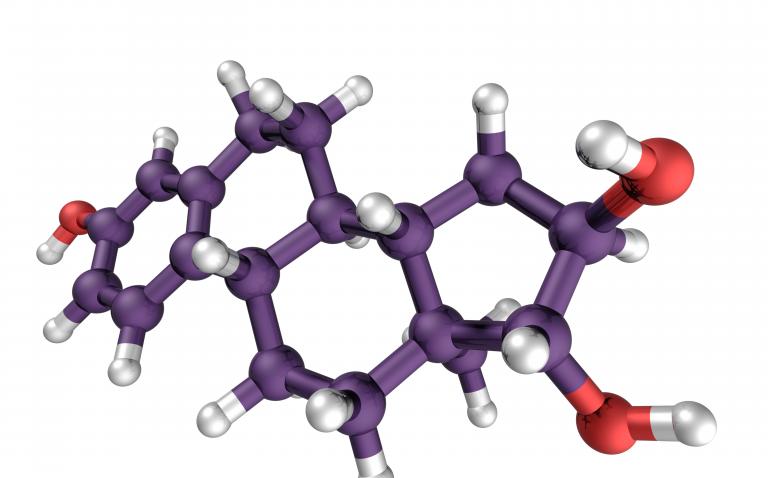Oestrogen is the quintessentially female hormone.
It is surprising, then, that a Medical University of South Carolina (MUSC) study found that a type of oestrogen, oestradiol, was more abundant in older men with scleroderma than in postmenopausal women with the disease. The MUSC team reports the findings of their National Institutes of Health (NIH)-funded study in Arthritis Research & Therapy.
The team also found that men with scleroderma and higher levels of estradiol had more severe disease and heart involvement. Those with the Scl-70 autoantibody and higher levels of estradiol had a greater risk of death.
In scleroderma, the body makes too much connective tissue. This causes thickening of the skin and internal organs and, ultimately, organ damage. Women are three times more likely, and women in their child-bearing years nine times more likely, to have the disease than men. Men, however, have more severe disease.
Scleroderma develops in women during their child-bearing years, when oestrogen levels are at their highest. This has led researchers to speculate that oestrogen may play a role in the disease, as well as other autoimmune diseases.
Further fuelling that speculation were findings from hormone replacement therapy trials that women’s skin thickened during therapy and then returned to normal after completion of treatment.
Carol Feghali-Bostwick, PhD, the SmartState and Kitty Trask Holt Endowed Chair for Scleroderma Research at MUSC and senior author of the article, has previously reported that similar thickening occurred in skin cultures exposed to oestradiol.
The MUSC team’s recent findings provide some of the first evidence to confirm a link between high oestrogen levels and the development of scleroderma. They also begin to explain why men, in whom the disease is less frequent, often have more severe symptoms.
“It seems reasonable to say that oestradiol is probably one of the reasons why men have more severe disease,” said Feghali-Bostwick.
“We always understood that women were more predisposed to getting autoimmune diseases,” said DeAnna Baker Frost, MD, PhD, first author of the article.
“We always thought that oestrogen played a role, but we needed additional research to identify associations between elevated oestrogen levels and clinical aspects of scleroderma. And so it was exciting to see that estrogen likely is playing a role in disease outcomes or maybe the development of autoimmune diseases.”
The team tested oestradiol and scleroderma autoantibody levels in banked samples from 83 men aged 50 years and older with diffuse cutaneous systemic sclerosis, a type of scleroderma. They also tested samples from 37 healthy men of a similar age. They then used a variety of statistical approaches and the careful clinical annotations accompanying each sample to determine whether estradiol levels were linked to any of the clinical traits of scleroderma.
Male patients with diffuse cutaneous scleroderma had significantly higher levels of estradiol (average, 30.6pg/ml) than both healthy men (average, 12.9pg/ml) and postmenopausal women with the disease (24.2pg/ml). Those with higher estradiol levels (average, 43.7pg/ml) had significantly more heart involvement than those with lower levels (29.4pg/ml). Finally, for patients with the Scl-70 autoantibody, increasing levels of estradiol in the serum was associated with a significantly greater risk of death.
But how is it possible for men to have such high levels of a hormone associated with the female reproductive system?
“Men can convert their testosterone to oestrogen via an enzyme called aromatase,” explained Feghali-Bostwick.
“They’re converting testosterone in their tissues. You don’t to have to have ovaries to make oestrogen. Other tissues can also form oestrogen.”
Aromatase can convert other tissues such as fat into oestrogen in women as well. Preventing that conversion could be a novel therapeutic approach to scleroderma.
Aromatase inhibitors are already being used to treat women, particularly postmenopausal women, with hormone-receptor positive breast cancer. The MUSC team would like to conduct a small trial to assess the efficacy of aromatase inhibitors in patients with scleroderma.
Even if the costs of a trial in patients with scleroderma prove to be too high, Feghali-Bostwick believes there is much to learn from existing data from large breast cancer trials of aromatase inhibitors. For example, she would be very curious how the aromatase inhibitors affected patients who had both breast cancer and scleroderma.
“What happened to their scleroderma when they were treated with aromatase inhibitors?” asked Feghali-Bostwick.
“Knowing that would help inform us about the utility of aromatase inhibitors. It’s hard to access the large breast cancer study data. However, doing so would provide us key information in assessing whether aromatase inhibitors have a role in scleroderma.”
Meanwhile, Baker Frost is conducting experiments to establish a causal link between higher estradiol levels and scleroderma.
“I think we also have to show concretely that having high oestrogen levels is the causative factor for the clinical characteristics of scleroderma,” said Baker Frost.
“So we’re doing a lot of studies with human tissues, and soon tissues from scleroderma patients, to show that if we treat these cells and tissues with estrogen, then the downstream effects will be the high levels of tissue scarring that you see with scleroderma.”
The MUSC’s team findings also point to oestrogen as a potential environmental trigger for scleroderma. Most people who develop the disease are likely genetically susceptible. However, research suggests that the environment also plays a role. “Oestrogen is around us. It’s not just what your body produces,” explained Feghali-Bostwick.
“There are a lot of things you get exposed to that affect oestrogen levels – things like endocrine disrupters and oestrogen mimics. So I think it’s just part of understanding what environmental factors may be involved in the development not just of scleroderma but also of related autoimmune diseases.”










